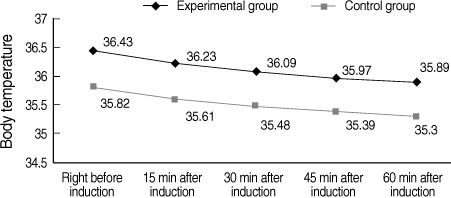J Korean Acad Nurs.
2010 Jun;40(3):317-325. 10.4040/jkan.2010.40.3.317.
The Effect of Pre-warming for Patients under Abdominal Surgery on Body Temperature, Anxiety, Pain, and Thermal Comfort
- Affiliations
-
- 1Operation Room, Konkuk University Hospital, Seoul, Korea. bada@kuh.ac.kr
- 2Department of Nursing, Konkuk University, Chungju, Korea.
- KMID: 987579
- DOI: http://doi.org/10.4040/jkan.2010.40.3.317
Abstract
- PURPOSE
The purpose of this study was to examine the effect of pre-warming on body temperature, anxiety, pain, and thermal comfort.
METHODS
Forty patients who were scheduled for abdominal surgery were recruited as study participants and were assigned to the experimental or control group. For the experimental group, a forced air warmer was applied for 45-90 min (M=68.25, SD=15.50) before surgery. Body temperature and anxiety were measured before and after the experiment, but pain and thermal comfort were assessed only after the surgery. Hypotheses were tested using t-test and repeated measured ANOVA.
RESULTS
The experimental group showed higher body temperature than the control group from right before induction to two hours after surgery. Post-operative anxiety and pain in the experimental group were less than those of the control group. In addition, the score of thermal comfort was significantly higher in the experiment group.
CONCLUSION
Pre-warming is effective in maintaining body temperature, lowering sensitivity to pain and anxiety, and promoting thermal comfort. Therefore, pre-warming can be recommended as a preoperative nursing intervention.
Keyword
MeSH Terms
Figure
Cited by 1 articles
-
Influence of Gas Pain, Post-operative Resilience, and Body Temperature Discomfort in Laparoscopic Myomectomy Patients after Thermotherapy
JeongAe Lee, MyoungHwa Jeon, EunJu Park, JinAh Lee, GonMyoung Ahn, SeungShin Lee, JiIn Kim
Korean J Women Health Nurs. 2019;25(1):4-18. doi: 10.4069/kjwhn.2019.25.1.4.
Reference
-
1. Andrzejowski J, Hoyle J, Eapen G, Turnbull D. Effect of prewarming on post-induction core temperature and the incidence of inadvertent perioperative hypothermia in patients undergoing general anaesthesia. British Journal of Anaesthesia. 2008. 101:627–631.2. Berman A, Snyder S, Kozier B, Erb G. Kozier & Erb's fundamentals of nursing: Concepts, process, and practice. 2008. 8th ed. Upper Saddle River, NJ: Prentice Hall Health.3. Berti M, Casati A, Torri G, Aldegheri G, Lugani D, Fanelli G. Active warming, not passive heat retention, maitains normothermia during combined epidural-general anesthesia for hip and knee arthroplasty. Journal of Clinical Anesthesia. 1997. 9:482–486.4. Borms S, Engelen S, Himpe D, Suy C, Theunissen W. Bair hugger forced-air warming maintains normothermai more effectively than thermo-lite insulation. Journal of Clinical Anesthesia. 1994. 6:303–307.5. Camus Y, Delva E, Sessler D, Lienhart A. Pre-induction skin-surface warming minimizes intraoperative core hypotheria. Journal of Clinical Anesthesia. 1995. 7:384–388.6. Cooper S. The effect of preoperative warming on patients' postoperative temperatures. AORN Journal. 2006. 83:1074–1076. 1079–1084.7. Fanelli A, Danelli G, Ghisi D, Ortu A, Moschini E, Fanelli G. The efficacy of a resistive heating under-patient blanket versus a forced-air warming system: A randomized controlled trial. Anesthesia and Analgesia. 2009. 108:199–201.8. Fossum S, Hays J, Henson MM. A comparison study on the effects of prewarming patients in the outpatient surgery setting. Journal of Perianesthesia Nursing. 2001. 16:187–194.9. Insler SR, Sessler DI. Perioperative thermoregulation and temperature monitoring. Anesthesiology Clinics. 2006. 24:823–837.10. Kiekkas P, Karga M. Prewarming: Preventing intraoperative hypothermia. British Journal of Perioperative Nursing. 2005. 15:444446–447. 449–451.11. Kim C, Baek W, Hong J, Park J, Kim B. Temperature changes during general anesthesia. Korean Journal of Anesthesiology. 1988. 21:27–32.12. Kim JY, Shinn H, Oh YJ, Hong YW, Kwak HJ, Kwak YL. The effect of skin surface warming during anesthesia preparation on preventing redistribution hypothermia in the early operative period of off-pump coronary artery bypass surgery. European Journal of Cardiothoracic Surgery. 2006. 29:343–347.13. Kolcaba K. Comfort theory and practice: A vision for holistic health care and research. 2003. New York, NY: Springer Publishing Co..14. Lim S, Cho M, Choi K. The effect of preoperative warming on reducing rectal temperature drop in surgical patients. Journal of Korean Academy of Adult Nursing. 1997. 9:55–69.15. Murat I, Berniere J, Constant I. Evaluation of the efficacy of a forced-air wamer (Bair Hugger) during spinal surgery in children. Journal of Clinical Anesthesia. 1994. 6:425–429.16. Negishi C, Hasegawa K, Mukai S, Nakagawa F, Ozaki M, Sessler DI. Resistive-heating and forced-air warmingare comparably effective. Anesthesia and Analgesia. 2003. 96:1683–1687.17. Odom M. Maintaining intraoperative normothermia: Ameta-analysis of outcomes with costs. AANA Journal. 1999. 67:155–164.18. Putzu M, Casati A, Berti M, Pagliarini G, Fanelli G. Clinical complications, monitoring and management of perioperative mild hypothermia: Anesthesiological features. Acta Biomedica. 2007. 78:163–169.19. Robinson S, Benton G. Warm blankets. Geriatric Nursing. 2002. 23:320–323.20. Rose DK, Cohen MM, Soutter DI. Laparoscopic cholecystectomy: The anaesthetist's point of view. Canadian Journal of Anaesthesia. 1992. 39:809–815.21. Sessler DI. Perioperative heat balance. Anesthesiology. 2000. 92:578–596.22. Sessler DI. Temperature monitoring and perioperative thermoregulation. Anesthesiology. 2008. 109:318–338.23. Spielberger C, Gorsuch R, Lushene R, Vagg P, Jacobs G. Manual for the state-trait anxiety inventory for adults. 1983. Palo Alto, CA: Consulting Psychologists Press.24. Vanni SM, Braz JR, Modolo NS, Amorim RB, Rodrigues GR Jr. Preoperative combined with intraoperative skin-surface warming avoids hypothermia caused by generalanesthesia and surgery. Journal of Clinical Anesthesia. 2003. 15:119–125.25. Wagner D, Byrne M, Kolcaba K. Effects of comfort warming on preoperative patients. AORN Journal. 2006. 84:427–448.26. Wilson L, Kolcaba K. Practical application of comfort theory in the perianesthesia setting. Journal of Perianesthesia Nursing. 2004. 19:164–173.
- Full Text Links
- Actions
-
Cited
- CITED
-
- Close
- Share
- Similar articles
-
- Effects of 10-min of pre-warming on inadvertent perioperative hypothermia in intraoperative warming patients: a randomized controlled trial
- Effect of short-term prewarming on body temperature in arthroscopic shoulder surgery
- The Effects of Active Warming on Pain, Temperature, and Thermal Discomfort in Postoperative Patients after General Anesthesia for Abdominal Surgery
- Comparison of upper and lower body forced air blanket to prevent perioperative hypothermia in patients who underwent spinal surgery in prone position: a randomized controlled trial
- The effect of 10 minutes of prewarming for prevention of inadvertent perioperative hypothermia: comparison with 30 minutes of prewarming



